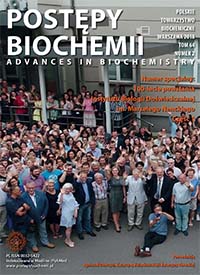What is and what is not cell senescence
DOI:
https://doi.org/10.18388/pb.2018_120Abstract
Cell senescence is a process that occurs due to telomere erosion or can be induced by various stresses. Senescent cells cease to divide but remain alive, metabolically active and able to secrete many molecules. They also show many hallmarks of senescence, such as enlarged size, increased granularity, increased activity of SA-β-galactosidase, increased level of cyclin-dependent kinase inhibitors, p16 and p21, and DNA damage foci. Originally, cell senescence was attributed to proliferating normal cells, in contrast to cancer cells, which were considered as those endowed with indefinite growth ability. Recently, it has become evident that anticancer
treatment induces senescence in cancer cells. Moreover, certain hallmarks of senescence were detected in non-proliferating post-mitotic cells. There are many signalling pathways involved in cell senescence, but the most prevalent is the DNA damage response pathway. In this review we have summarized our long lasting input in the global study of the mechanisms of senescence of normal and cancer cells and discussed the diversity of the concept of cell senescence.
Downloads
Published
Issue
Section
License
All journal contents are distributed under the Creative Commons Attribution-ShareAlike 4.0 International (CC BY-SA 4.0) license. Everybody may use the content following terms: Attribution — You must give appropriate credit, provide a link to the license, and indicate if changes were made, ShareAlike — If you remix, transform, or build upon the material, you must distribute your contributions under the same license as the original. There are no additional restrictions — You may not apply legal terms or technological measures that legally restrict others from doing anything the license permits.
Copyright for all published papers © stays with the authors.
Copyright for the journal: © Polish Biochemical Society.




